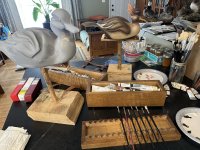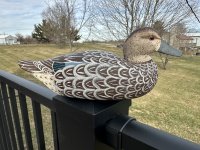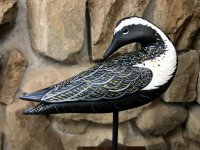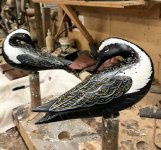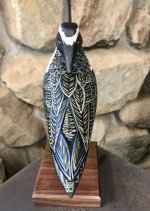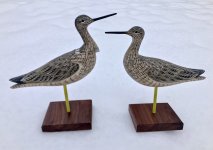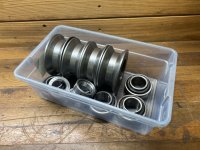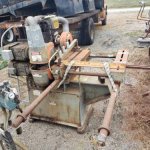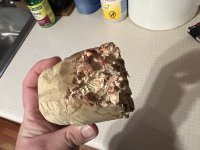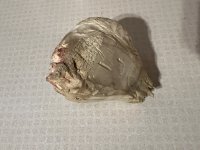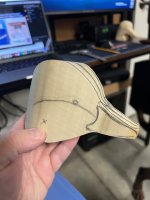February workbench
- Thread starter patrick mccarthy
- Start date
Vince Pagliaroli
Well-known member
Patrick,
Looking good.
To quote the title of Thomas Aquinas Daly's book - THE PAINTING SEASON.
It's here now.
Oil paint Least Bittern on wine case lid. Was inspired as I watched one up close last year while fly fishing. The smallest member of the Heron family and can really do a disappearing act in little to no cover. Amazing to see.
Looking good.
To quote the title of Thomas Aquinas Daly's book - THE PAINTING SEASON.
It's here now.
Oil paint Least Bittern on wine case lid. Was inspired as I watched one up close last year while fly fishing. The smallest member of the Heron family and can really do a disappearing act in little to no cover. Amazing to see.
Attachments
patrick mccarthy
Well-known member
Beautiful work VincePatrick,
Looking good.
To quote the title of Thomas Aquinas Daly's book - THE PAINTING SEASON.
It's here now.
Oil paint Least Bittern on wine case lid. Was inspired as I watched one up close last year while fly fishing. The smallest member of the Heron family and can really do a disappearing act in little to no cover. Amazing to see.
Cody Foster
New member
jode hillman
Well-known member
Love it Vince, always something cool.Patrick,
Looking good.
To quote the title of Thomas Aquinas Daly's book - THE PAINTING SEASON.
It's here now.
Oil paint Least Bittern on wine case lid. Was inspired as I watched one up close last year while fly fishing. The smallest member of the Heron family and can really do a disappearing act in little to no cover. Amazing to see.
I made a few dovetail birds, let see if I can attach.
Video of the dovetails action.....
Attachments
The restoration of my Newman tenoner has commenced. This is going to be the most complicated and difficult restoration I've done. The machine was sitting in the open and headed to the scrap yard when I bought it. I expect this project will run me into the fall to complete.
So far I have the bed and rails off the machine and the parts de-rusted and cleaned. Also, one of the rails was bent and the cast iron support was cracked. I had the cast iron repaired (beyond my skill to do it properly) and replaced the rail. 1 15/16" turned, ground, and polished (TGP) stock isn't cheap, plus the holes had to be machined. I hope to put power to her today just to see what happens. Nothing exciting, but progress nonetheless.
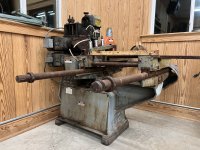
So far I have the bed and rails off the machine and the parts de-rusted and cleaned. Also, one of the rails was bent and the cast iron support was cracked. I had the cast iron repaired (beyond my skill to do it properly) and replaced the rail. 1 15/16" turned, ground, and polished (TGP) stock isn't cheap, plus the holes had to be machined. I hope to put power to her today just to see what happens. Nothing exciting, but progress nonetheless.

Attachments
Some friends and I got to tour Mattamuskeet Lodge last month. Inside I saw an old silhouette goose decoy, which inspired me to make some of my own. I aged these decoys with antiquing wax. I think it gives them a good "vintage" vibe. I also sealed the wood with water sealer before painting...hopefully they'll last a while. The ground stakes are old tobacco sticks I salvaged from a tobacco barn here in Pitt County, NC. I stamped a couple of the stakes with the names of Mattamuskeet and Off Island, just for kicks. You can see before and after picks at the end.
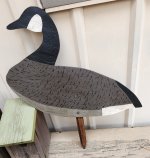
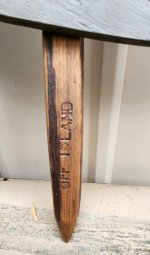
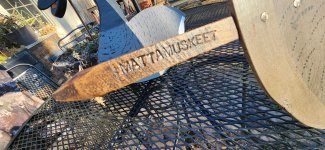
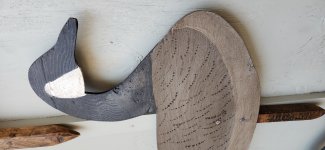
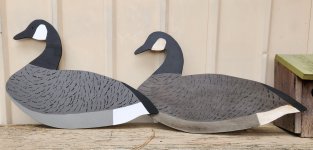
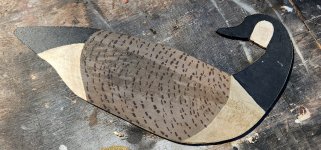
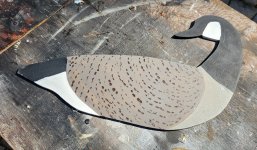







The machine looks heavy. I suspect either the bent rail got hit with a fork truck or some one lifted the machine using it as a lifting point. 1 15/16 is fairly stout material. Looks like a direct drive separate motor for each cutterhead? What's that going to pull power wise when you fire it up?1 15/16" turned, ground, and polished (TGP) stock isn't cheap, plus the holes had to be machined.
Dave
Those bars and the cast iron support are very stout. I think it would take more than lifting to crack and bend them. I think a forklift dropped it and it pivoted slamming one side down, if I had to guess.
It has five motors. The two tenon cutters are two hp, the coping heads are one hp, and the cutoff is two hp, for a total of eight hp. I should be able to run it with my rotary phase converter no problem (40 amp circuit). Keep in mind at most two motors are engaged in the wood at once unless I'm working a very wide board. In that case I wouldn't be running the coping heads.
The weight is listed at over a ton. I believe it. I just hope other than the base I can lift each individual component. Otherwise, I'll use the hoist to pick up parts.
Can you imagine what a machine like this would cost to manufacture today? It would easily be 25k.
After I brought it home I posted on the vintage machinery site and had another owner, Jack Cadwell, contact me. He lives in Massachusetts and has made a career of making/repairing historical home windows in the New England area. He told me this machine is the very best of the mid-sized tenoners ever made and one could make a living with it. Note I said mid-sized. They get bigger. He owned and operated several tenoners over his career and thought the Newman was the best engineered with its large capacities in a small package and ease of adjusting and holding settings. One thing is for sure, the designers at Newman like dovetail ways because this thing is essentially a compound slide attached to every motor. I'm sure you can appreciate that fact.
BTW, if anyone in the New England area need custom sash work done you should call Jack. His webiste is below and the last picture is of his Newman.
Those bars and the cast iron support are very stout. I think it would take more than lifting to crack and bend them. I think a forklift dropped it and it pivoted slamming one side down, if I had to guess.
It has five motors. The two tenon cutters are two hp, the coping heads are one hp, and the cutoff is two hp, for a total of eight hp. I should be able to run it with my rotary phase converter no problem (40 amp circuit). Keep in mind at most two motors are engaged in the wood at once unless I'm working a very wide board. In that case I wouldn't be running the coping heads.
The weight is listed at over a ton. I believe it. I just hope other than the base I can lift each individual component. Otherwise, I'll use the hoist to pick up parts.
Can you imagine what a machine like this would cost to manufacture today? It would easily be 25k.
After I brought it home I posted on the vintage machinery site and had another owner, Jack Cadwell, contact me. He lives in Massachusetts and has made a career of making/repairing historical home windows in the New England area. He told me this machine is the very best of the mid-sized tenoners ever made and one could make a living with it. Note I said mid-sized. They get bigger. He owned and operated several tenoners over his career and thought the Newman was the best engineered with its large capacities in a small package and ease of adjusting and holding settings. One thing is for sure, the designers at Newman like dovetail ways because this thing is essentially a compound slide attached to every motor. I'm sure you can appreciate that fact.
BTW, if anyone in the New England area need custom sash work done you should call Jack. His webiste is below and the last picture is of his Newman.
Attachments
Last edited:
My latest project involved a bit of 3D printing. The completed build, is a device used to check the orientation of the spine in any arrow shaft. The hanger in the middle carries a 3 lb. steel weight. In a 19 inch spread I was getting about .080 deflection. The actual deflection is irrelevant. The important issue is; when the shaft is rotated, does the deflection stay the same or is there a point in which there is greater deflection?
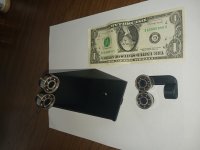
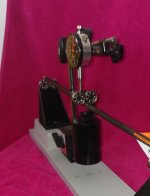
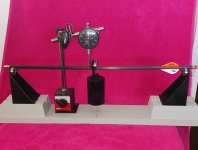



Richard Lathrop
Active member
Eric,Dave
Those bars and the cast iron support are very stout. I think it would take more than lifting to crack and bend them. I think a forklift dropped it and it pivoted slamming one side down, if I had to guess.
It has five motors. The two tenon cutters are two hp, the coping heads are one hp, and the cutoff is two hp, for a total of eight hp. I should be able to run it with my rotary phase converter no problem (40 amp circuit). Keep in mind at most two motors are engaged in the wood at once unless I'm working a very wide board. In that case I wouldn't be running the coping heads.
The weight is listed at over a ton. I believe it. I just hope other than the base I can lift each individual component. Otherwise, I'll use the hoist to pick up parts.
Can you imagine what a machine like this would cost to manufacture today? It would easily be 25k.
After I brought it home I posted on the vintage machinery site and had another owner, Jack Cadwell, contact me. He lives in Massachusetts and has made a career of making/repairing historical home windows in the New England area. He told me this machine is the very best of the mid-sized tenoners ever made and one could make a living with it. Note I said mid-sized. They get bigger. He owned and operated several tenoners over his career and thought the Newman was the best engineered with its large capacities in a small package and ease of adjusting and holding settings. One thing is for sure, the designers at Newman like dovetail ways because this thing is essentially a compound slide attached to every motor. I'm sure you can appreciate that fact.
BTW, if anyone in the New England area need custom sash work done you should call Jack. His webiste is below and the last picture is of his Newman.
Making lock box cabinets with divided pane glass doors?
Rick Lathrop
Richard Lathrop
Active member
Dave,My latest project involved a bit of 3D printing. The completed build, is a device used to check the orientation of the spine in any arrow shaft. The hanger in the middle carries a 3 lb. steel weight. In a 19 inch spread I was getting about .080 deflection. The actual deflection is irrelevant. The important issue is; when the shaft is rotated, does the deflection stay the same or is there a point in which there is greater deflection?
View attachment 64414
View attachment 64415
View attachment 64416
That looks similar to the drive shaft straightening tools used by YouTube creators like Keith Fenner at Turnwright.
Rick Lathrop
Rick
Nope. Entry doors.
Nope. Entry doors.
Rick,Eric,
Making lock box cabinets with divided pane glass doors?
Rick Lathrop
Eric bought this machine because it was old and needed rebuilt. That, and now he is the only kid on his block that has one.
Dave
You forgot dirt cheap.
You forgot dirt cheap.
Won't be when you get done with it.... just like a free boat!Dave
You forgot dirt cheap.
Vince Pagliaroli
Well-known member
Lots of good projects goin' on this month. The longest short month of the year....
Jode, yer dovetailed shorebirds are Killers. Two thumbs way UP.
Best regards
Vince
Jode, yer dovetailed shorebirds are Killers. Two thumbs way UP.
Best regards
Vince

